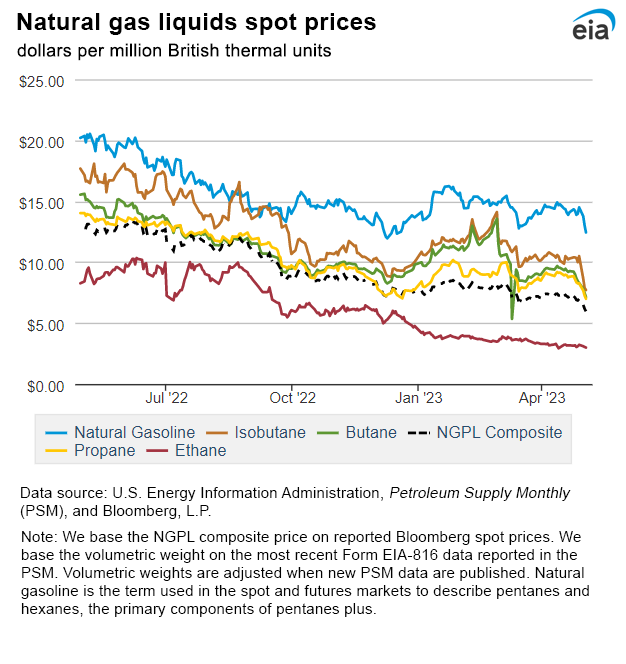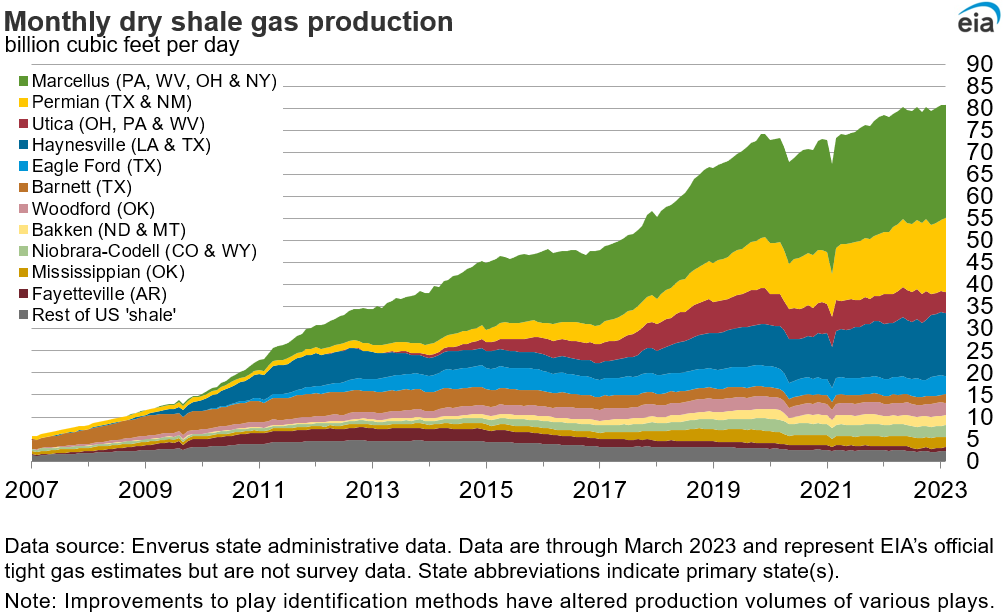In the News:
U.S. natural gas power burn during the heating season was the highest on record this past winter
Natural gas consumed for electric power generation in the United States during the 2022–2023 winter heating season (November 1–March 31) averaged 30.6 billion cubic feet per day (Bcf/d), the highest winter heating season average on record, based on data from S&P Global Commodity Insights. Natural gas consumed for electric power generation has increased most winter heating seasons since 2016–2017 with the continued reductions in coal-fired electricity generation and the overall growth in electricity demand.
Coal and natural gas are two of the most prevalent sources of power generation in the United States. Natural gas-fired generation capacity in the United States has grown in recent years, although coal-fired generation has continued to decline. Lower coal-fired generation is due to a long-term trend of coal power plant retirements and increased competition with natural gas-fired combined-cycle plants when natural gas prices are low. A total of 11.5 gigawatts (GW) of U.S. coal-fired electricity generating capacity retired in 2022. No new coal-fired capacity has come online since 2013, and developers have not reported any plans to build new U.S. coal-fired capacity in the future. In contrast, nearly 6.1 GW of natural gas-fired capacity was added in 2022, according to our Preliminary Monthly Electric Generator Inventory.
The share of electricity generation from natural gas averaged 37.7% during the 2022–2023 winter heating season, up from 35.2% the previous year; generation from coal averaged 17.8%, down from 20.6% the previous year, based on estimates from our April Short-Term Energy Outlook (STEO).
Total electricity generation in the United States topped 1,600 billion kilowatthours for the second time this past winter heating season, based on estimates from our April STEO. As overall electricity demand has increased, multiple sources of electricity generation, including natural gas, wind, and solar, increased to meet the demand.
Natural gas consumed for electric power generation was especially high in both the Western and Rocky Mountain regions this past winter due to colder-than-normal temperatures and decreased electricity generation from hydropower in parts of the region compared with last winter. In the Western region, where electricity is a major fuel source for heating, natural gas consumed in the electric power sector averaged 21.3 Bcf/d, 16% (2.9 Bcf/d) higher than the five-year (2017–2018 to 2021–2022) winter heating season average, based on data from S&P Global Commodity Insights. Natural gas consumption remained high in this region despite record-high natural gas prices this past winter. Natural gas consumed in the electric power sector in the Rocky Mountain region averaged 3.6 Bcf/d, 39% (1.0 Bcf/d) higher than the five-year average.
Market Highlights:
(For the week ending Wednesday, May 3, 2023)Prices
- Henry Hub spot price: The Henry Hub spot price fell 16 cents from $2.19 per million British thermal units (MMBtu) last Wednesday to $2.03/MMBtu yesterday.
- Henry Hub futures prices: The May 2023 NYMEX contract expired last Wednesday at $2.117/MMBtu. The June 2023 NYMEX contract price decreased to $2.170/MMBtu, down 14 cents from last Wednesday to yesterday. The price of the 12-month strip averaging June 2023 through May 2024 futures contracts declined 10 cents to $2.942/MMBtu.
- Select regional spot prices: Natural gas spot prices broadly declined this report week (Wednesday, April 26, to Wednesday, May 3), with few exceptions. Price changes at major pricing hubs this report week ranged from a decrease of $4.87/MMBtu at SoCal Citygate in Southern California to an increase of 3 cents/MMBtu at Algonquin Citygate in the Northeast.
- Prices at most Northeast trading points fell this report week despite lower temperatures and higher residential and commercial sector heating demand, reflecting a downward price trend across the country. Natural gas demand declined in line with seasonal trends while production remained high. The Tennessee Zone 4 Marcellus spot price decreased 31 cents from $1.50/MMBtu last Wednesday to $1.19/MMBtu yesterday, the lowest price among major pricing hubs. In the New York-Central Park Area, temperatures averaged 52°F this report week, leading to 88 heating degree days (HDDs), which is 28 more HDDs than last week. In the Northeast, week-over-week consumption of natural gas in all sectors increased slightly, by 2% (0.4 billion cubic feet per day [Bcf/d]).
- Prices in the Midwest also declined this week. At the Chicago Citygate, the price decreased 13 cents from $1.98/MMBtu last Wednesday to $1.85/MMBtu yesterday. In the Chicago Area temperatures averaged 49°F this report week, leading to 112 HDDs, which is 17 fewer HDDs than last week. Average weekly consumption of natural gas across all sectors in the Midwest declined 14%, or 1.8 Bcf/d week over week, according to data from S&P Global Commodity Insights.
- Prices at major pricing hubs across the western United States declined this report week, with most prices falling below the Henry Hub price on Wednesday. In the Pacific Northwest, the price at Sumas on the Canada-Washington border fell $1.44 from $2.79/MMBtu last Wednesday to $1.35/MMBtu yesterday, its lowest price since July 2, 2020, when it was $1.28/MMBtu. Consumption of natural gas in all sectors in the Pacific Northwest region declined 28% (0.5 Bcf/d) week over week, driven by a 50% (0.4 Bcf/d) decline in consumption in the residential and commercial sectors, as temperatures increased to above normal for this time of year. In the Seattle City Area, temperatures averaged 59°F this report week, which is 5°F above normal, leading to 52 fewer HDDs than last week.
- Prices in California declined this week, in line with prices across the western United States. The price at SoCal Citygate in Southern California decreased $4.87 from $6.86/MMBtu last Wednesday to $1.99/MMBtu yesterday, its lowest price since October 9, 2020, when it was $1.86/MMBtu, bringing the SoCal Citygate price near those of other major pricing hubs and only 4 cents below the Henry Hub. In the Riverside Area, inland from Los Angeles, temperatures averaged 65°F, which is less than 1°F below normal, though they fluctuated above and below 65°F during the week, leading to 33 heating and cooling degree days combined. In Northern California, the price at PG&E Citygate fell 1 cent, down from $4.75/MMBtu last Wednesday to $4.74/MMBtu yesterday, the highest price among major pricing hubs. Prices at PG&E Citygate remain elevated relative to prices at other regional hubs due to two major maintenance events on PG&E pipelines that bring natural gas into the consumption area. Both the Redwood path, delivering natural gas from the north, and the Baja path, delivering natural gas from the southwest, are undergoing maintenance that has reduced system deliverability by close to 0.8 Bcf/d. Overall, across the western United States, including the Pacific Northwest, California, the Desert Southwest, and Rocky Mountain regions, natural gas consumption in all sectors declined 10% (1.2 Bcf/d), mostly due to a 21% (0.8 Bcf/d) decrease in consumption in the residential and commercial sectors.
- International futures prices: International natural gas futures prices decreased this report week. According to Bloomberg Finance, L.P., weekly average front-month futures prices for liquefied natural gas (LNG) cargoes in East Asia fell 36 cents to a weekly average of $11.54/MMBtu. Natural gas futures for delivery at the Title Transfer Facility (TTF) in the Netherlands fell 52 cents to a weekly average of $12.32/MMBtu. In the same week last year (week ending May 4, 2022), the prices were $24.08/MMBtu in East Asia and $30.90/MMBtu at TTF.
- Natural gas plant liquids (NGPL) prices: The natural gas plant liquids composite price at Mont Belvieu, Texas, fell by 60 cents/MMBtu, averaging $6.49/MMBtu for the week ending May 3. Weekly average ethane prices fell 2%, while natural gas prices at the Houston Ship Channel rose 2%, narrowing the ethane premium to natural gas by 7% week over week. Ethylene spot prices fell by 9%, decreasing the ethylene to ethane premium by 13%. Propane prices fell 11%, while the Brent crude oil price fell by 4%, resulting in a 7% increase in the propane discount relative to crude oil. Natural gasoline prices fell 4%, following the Brent crude oil price. The normal butane price fell 14% and isobutane fell 13%.
Daily spot prices by region are available on the EIA website.
Supply and Demand
- Supply: According to data from S&P Global Commodity Insights, the average total supply of natural gas rose by 0.2% (0.2 Bcf/d) week over week, to 106.8 Bcf/d. Dry natural gas production grew by 0.3% (0.3 Bcf/d) to average a weekly record-high of 101.8 Bcf/d, while average net imports from Canada were relatively unchanged at 5.0 Bcf/d.
- Demand: Total U.S. consumption of natural gas fell by 3.7% (2.7 Bcf/d) week over week to 70.5 Bcf/d, according to data from S&P Global Commodity Insights. Natural gas consumed in all three major sectors declined: residential and commercial sector consumption declined by 8.1% (1.7 Bcf/d), power generation consumption declined by 2.3% (0.7 Bcf/d), and industrial sector consumption declined by 1.4% (0.3 Bcf/d). Natural gas exports to Mexico decreased 4.3% (0.2 Bcf/d) to 5.4 Bcf/d, and natural gas deliveries to U.S. LNG export facilities (LNG pipeline receipts) decreased 4.1% (0.6 Bcf/d) to 13.4 Bcf/d. Demand for feedgas at U.S. export terminals typically declines at this time of year, when exports are seasonally lower.
Liquefied Natural Gas (LNG)
- Pipeline receipts: Average natural gas deliveries to U.S. LNG export terminals decreased by 4.1% (0.6 Bcf/d) week over week to average 13.4 Bcf/d this report week, according to data from S&P Global Commodity Insights. Natural gas deliveries to terminals in South Texas increased by 10.0% (0.4 Bcf/d) to 4.5 Bcf/d, while deliveries to terminals in South Louisiana decreased by 10.9% (0.9 Bcf/d) to 7.7 Bcf/d. Natural gas deliveries to terminals outside the Gulf Coast were essentially unchanged at 1.2 Bcf/d.
- Vessels departing U.S. ports: Twenty-three LNG vessels (eight from Sabine Pass; four from Freeport; three each from Calcasieu Pass, Cameron, and Corpus Christi; and one each from Cove Point and Elba Island) with a combined LNG-carrying capacity of 87 Bcf departed the United States between April 27 and May 3, according to shipping data provided by Bloomberg Finance, L.P.
Rig Count
- According to Baker Hughes, for the week ending Tuesday, April 25, the natural gas rig count increased by 2 rigs from a week ago to 161 rigs. The Marcellus and Utica each added one rig, and one rig was added in an unidentified producing region, while the Haynesville dropped one rig. The number of oil-directed rigs was unchanged from a week ago at 591 rigs. The Permian added three rigs and three rigs were added in unidentified producing regions, while the Cana Woodford dropped two rigs, and the Ardmore Woodford, Eagle Ford, Granite Wash, and Williston each dropped one rig. The total rig count, which includes 3 miscellaneous rigs, stands at 755, which is 57 more rigs than last year at this time.
Storage
- The net injections into storage totaled 54 Bcf for the week ending April 28, compared with the five-year (2018–2022) average net injections of 78 Bcf and last year's net injections of 72 Bcf during the same week. Working natural gas stocks totaled 2,063 Bcf, which is 341 Bcf (20%) more than the five-year average and 507 Bcf (33%) more than last year at this time.
- According to The Desk survey of natural gas analysts, estimates of the weekly net change to working natural gas stocks ranged from net injections of 46 Bcf to 60 Bcf, with a median estimate of 53 Bcf.
See also:
Top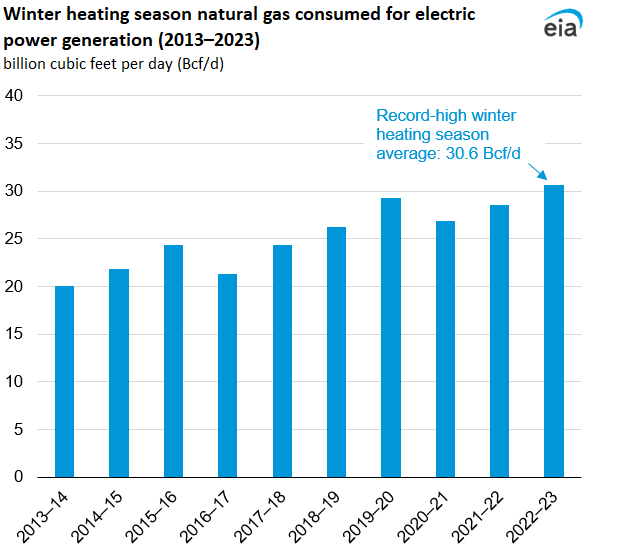
Data source: S&P Global Commodity Insights
Note: The winter heating season for natural gas is November–March.
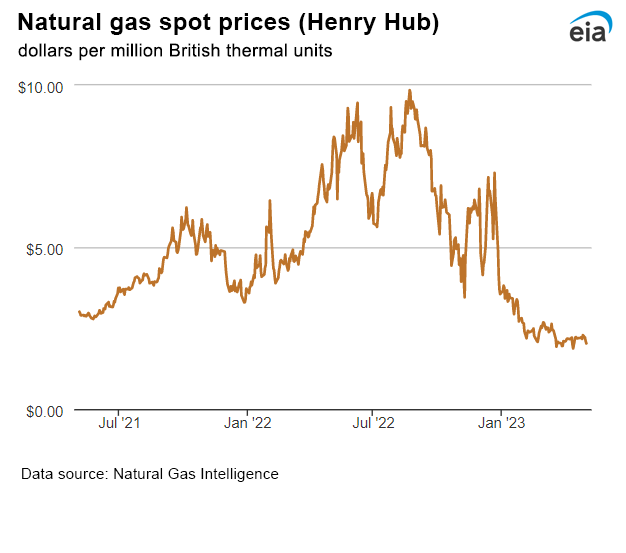
| Spot Prices ($/MMBtu) | Thu, 27-Apr |
Fri, 28-Apr |
Mon, 01-May |
Tue, 02-May |
Wed, 03-May |
|---|---|---|---|---|---|
| Henry Hub |
2.17 |
2.28 |
2.21 |
2.10 |
2.03 |
| New York |
1.58 |
1.90 |
2.13 |
1.84 |
1.70 |
| Chicago |
1.95 |
2.14 |
2.16 |
2.05 |
1.85 |
| Cal. Comp. Avg.* |
2.82 |
3.28 |
3.05 |
3.06 |
2.77 |
| Futures ($/MMBtu) | |||||
| June contract | 2.355 |
2.410 |
2.318 |
2.214 |
2.170 |
| July contract |
2.548 |
2.578 |
2.498 |
2.417 |
2.360 |
| *Avg. of NGI's reported prices for: Malin, PG&E Citygate, and Southern California Border Avg. | |||||
| Source: NGI's Daily Gas Price Index | |||||
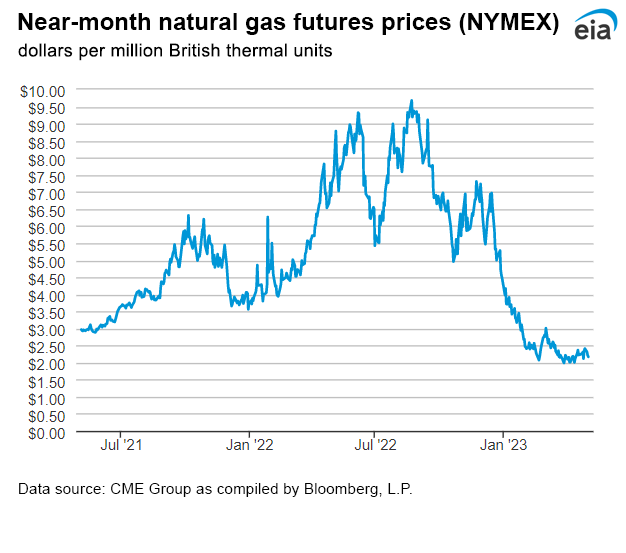
| U.S. natural gas supply - Gas Week: (4/27/23 - 5/3/23) | |||
|---|---|---|---|
Average daily values (billion cubic feet) |
|||
this week |
last week |
last year |
|
| Marketed production | 114.6 |
114.3 |
108.3 |
| Dry production | 101.8 |
101.5 |
95.6 |
| Net Canada imports | 5.0 |
5.0 |
5.8 |
| LNG pipeline deliveries | 0.1 |
0.1 |
0.1 |
| Total supply | 106.8 |
106.6 |
101.5 |
|
Data source: S&P Global Commodity Insights | |||
| U.S. natural gas consumption - Gas Week: (4/27/23 - 5/3/23) | |||
|---|---|---|---|
Average daily values (billion cubic feet) |
|||
this week |
last week |
last year |
|
| U.S. consumption | 70.5 |
73.3 |
67.9 |
| Power | 28.4 |
29.0 |
25.5 |
| Industrial | 22.4 |
22.7 |
22.8 |
| Residential/commercial | 19.8 |
21.5 |
19.5 |
| Mexico exports | 5.4 |
5.6 |
6.0 |
| Pipeline fuel use/losses | 6.9 |
7.0 |
6.5 |
| LNG pipeline receipts | 13.4 |
14.0 |
12.2 |
| Total demand | 96.2 |
99.8 |
92.6 |
|
Data source: S&P Global Commodity Insights | |||
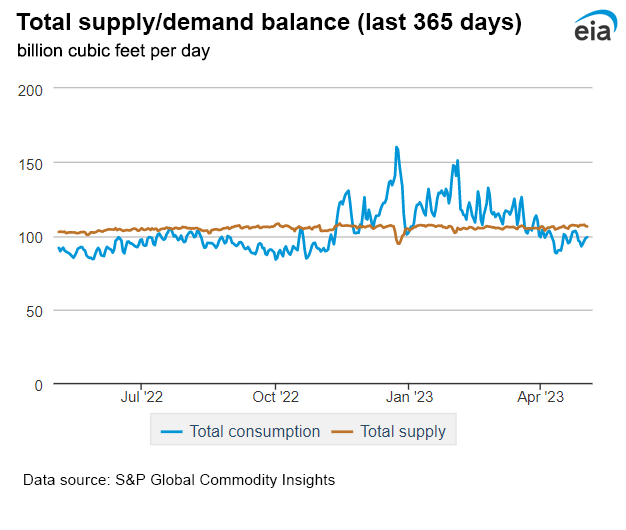
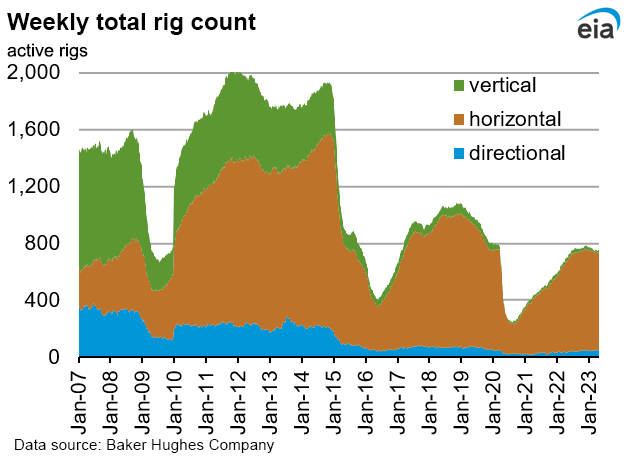
| Rigs | |||
|---|---|---|---|
Tue, April 25, 2023 |
Change from |
||
last week |
last year |
||
| Oil rigs | 591 |
0.0% |
7.1% |
| Natural gas rigs | 161 |
1.3% |
11.8% |
| Note: Excludes any miscellaneous rigs | |||
| Rig numbers by type | |||
|---|---|---|---|
Tue, April 25, 2023 |
Change from |
||
last week |
last year |
||
| Vertical | 23 |
27.8% |
-8.0% |
| Horizontal | 685 |
-0.3% |
6.5% |
| Directional | 47 |
-2.1% |
56.7% |
| Data source: Baker Hughes Company | |||
| Working gas in underground storage | ||||
|---|---|---|---|---|
Stocks billion cubic feet (Bcf) |
||||
| Region | 2023-04-28 |
2023-04-21 |
change |
|
| East | 410 |
390 |
20 |
|
| Midwest | 481 |
468 |
13 |
|
| Mountain | 95 |
90 |
5 |
|
| Pacific | 100 |
90 |
10 |
|
| South Central | 977 |
971 |
6 |
|
| Total | 2,063 |
2,009 |
54 |
|
| Data source: U.S. Energy Information Administration Form EIA-912, Weekly Underground Natural Gas Storage Report | ||||
| Working gas in underground storage | |||||
|---|---|---|---|---|---|
Historical comparisons |
|||||
Year ago (4/28/22) |
5-year average (2018-2022) |
||||
| Region | Stocks (Bcf) |
% change |
Stocks (Bcf) |
% change |
|
| East | 251 |
63.3 |
301 |
36.2 |
|
| Midwest | 322 |
49.4 |
360 |
33.6 |
|
| Mountain | 92 |
3.3 |
97 |
-2.1 |
|
| Pacific | 175 |
-42.9 |
193 |
-48.2 |
|
| South Central | 715 |
36.6 |
772 |
26.6 |
|
| Total | 1,556 |
32.6 |
1,722 |
19.8 |
|
| Data source: U.S. Energy Information Administration Form EIA-912, Weekly Underground Natural Gas Storage Report | |||||
| Temperature – heating & cooling degree days (week ending Apr 27) | ||||||||
|---|---|---|---|---|---|---|---|---|
HDDs |
CDDs |
|||||||
| Region | Current total |
Deviation from normal |
Deviation from last year |
Current total |
Deviation from normal |
Deviation from last year |
||
| New England | 111 |
0 |
1 |
0 |
0 |
0 |
||
| Middle Atlantic | 92 |
-3 |
5 |
0 |
0 |
0 |
||
| E N Central | 142 |
43 |
58 |
0 |
0 |
-5 |
||
| W N Central | 147 |
59 |
47 |
0 |
-2 |
-4 |
||
| South Atlantic | 53 |
10 |
25 |
21 |
1 |
-6 |
||
| E S Central | 69 |
31 |
46 |
0 |
-7 |
-19 |
||
| W S Central | 40 |
26 |
30 |
17 |
-11 |
-35 |
||
| Mountain | 117 |
20 |
25 |
9 |
-2 |
-1 |
||
| Pacific | 30 |
-27 |
-31 |
0 |
-4 |
0 |
||
| United States | 90 |
17 |
23 |
6 |
-4 |
-7 |
||
|
Data source: National Oceanic and Atmospheric Administration Note: HDDs=heating degree days; CDDs=cooling degree days | ||||||||
Average temperature (°F)
7-day mean ending Apr 27, 2023
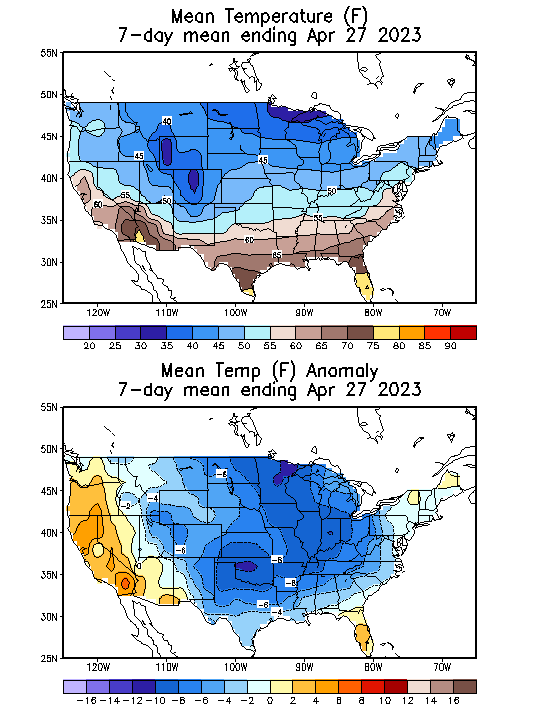
Data source: National Oceanic and Atmospheric Administration
Deviation between average and normal temperature (°F)
7-day mean ending Apr 27, 2023

Data source: National Oceanic and Atmospheric Administration

